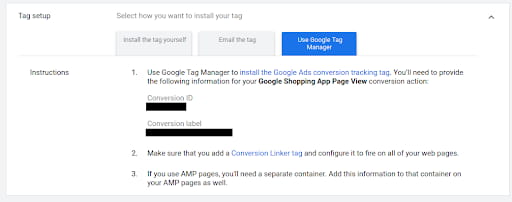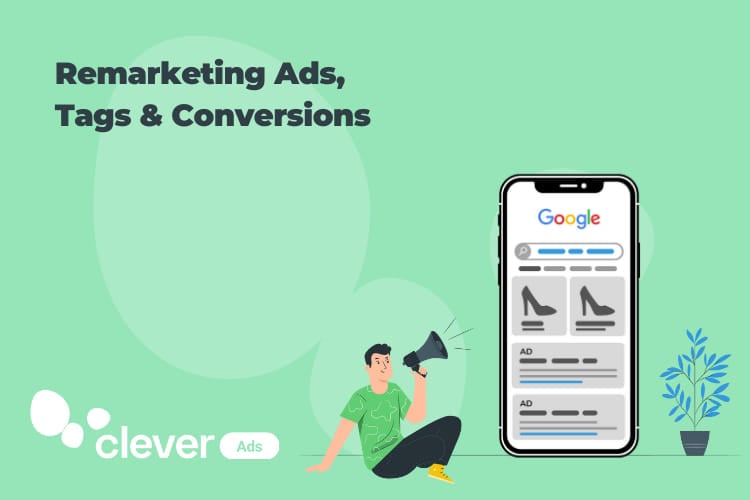How to Create Conversion & Remarketing Ads With Tags
How do you get the most out of your Google Ads with tags? In order to help Google Ads to be able to keep track of the products that are visited or how much certain products have been purchased through ads, it is necessary to insert a series of labels on your website.
These tags are javascript codes that are inserted into your website to offer some benefit or help to platforms such as Google Ads. As a result, this improves ad performance by having more information.
The different types of tags
Conversion Tag
You first need to connect your Google Ads account with the website so that Google Ads can know that a conversion has been made. This way it’s easy to check the performance that a campaign is having with precision.
This tag records when a user or customer clicks on an ad to enter the website. Once within the web they can perform an action (as in the case of an eCommerce, it can be a purchase), so a conversion assigned to the specific campaign of that ad would be performed. This makes it so there is more information to evaluate the performance of certain ads by checking which one has been able to sell more or less.
Remarketing Tag
This tag has the function of following a user who has already visited your website or a specific product, and is able to show an ad related to what they have visited.
In order to generate ads that capture potential buyers who have already visited a product, it is necessary to add this label. This tag is a block of code that adds visitors of a website to remarketing lists, which can then be used for targeted ads.
To re-attract these potential customers, you can use Remarketing campaigns or even smart Shopping campaigns that also use this information.
Google Tag Manager
This is a tool that simplifies the management of your website’s tags in an easy and fast way. It allows not only to add tags, but also to implement analytical and tag configurations from a simple and secure interface.
In order to start using this tool it is necessary to create an account at Tag Managger by adding your country and your website. Once registered, two blocks of JavaScript code will appear for you to insert on each page of your website. These codes will have to be directly copied into the <head> or <body> tags of your pages as indicated by Google Tag Manager. Once introduced, you will have Google Tag Manager ready to enter new tags.
Once everything is configured you will be able to create tags. A section will appear in which you can add a new tag or you can enter the tags section to create them. There is an extensive list of labels to choose from, including the ones previously mentioned.
You can configure which tags you want to run on certain pages of your website, depending on the strategy you want to follow. For example, if you only want to track the products that are visited, it would only be necessary to enable a tag for the product pages.
To finish configuring the Remarketing and Conversion tags, you need to fill in fields such as conversion ID and conversion label, which can be found in Google Ads.
The ID necessary for a Remarketing tag can be found in Audience Manager:
<Audience sources <Google Ads Tag Details <Tag Setup and conversion tag in Conversions <Your conversion action <Tag Setup

Once the labels have been configured, they must be published so that they are activated on your website. It is as simple as pressing the submit button and assigning a name and description about the labels to be published. This way, all the tags configured in the workspace will be published and in a few seconds it will be enabled on your website and ready to improve your integration with Google Ads.
What about Microsoft?
Similar to Google Ads, Microsoft Ads (formerly known as Bing Ads) remarketing allows you to show targeted ads to users who have previously interacted with your website or app. These ads are displayed across the Microsoft Search Network, as well as on its partner sites and the Microsoft Display Network.
How to set up Microsoft remarketing
To get started with Microsoft remarketing, you must follow the steps below:
- Create a Microsoft Advertising account – If you do not already have a Microsoft Advertising account, you must create one before you can set up remarketing.
- Add the remarketing tag to your website or app: As with Google Ads, in order for Microsoft Ads to track users who have interacted with your site, you must add a remarketing tag to your website or app.
- Create remarketing lists: Once you have added the remarketing tag, you can create remarketing lists based on the actions users have taken on your site. For example, you can create a list of users who have visited a specific product page or a list of users who have added a product to their cart but have not purchased it.
- Create remarketing ads: Finally, you can create specific ads for each remarketing list you have created. You can customize the ad text and images to be relevant to each remarketing list.
Benefits of Microsoft remarketing
Microsoft remarketing has several benefits, including:
- Reaching a relevant audience: By showing ads only to users who have previously interacted with your website or app, Microsoft remarketing allows you to reach a more relevant audience and increase the likelihood of conversion.
- More control over your ads: By creating remarketing lists based on specific actions users have taken on your website, you can create more targeted and relevant ads for each list.
- More opportunities for conversion: By showing ads to users who have already interacted with your website or application, Microsoft remarketing gives you more opportunities to convert those users into customers.
To conclude…
We hope we’ve been able to expand your knowledge about remarketing ad tags in both Google and Microsoft, as well as conversion tags. If you need more information on this subject, such as knowing what dynamic remarketing is or a more specific guide for your remarketing campaigns… Don’t hesitate to read our posts!




